By Sara Century
Mystique may be best known through the Fox film franchise, but our girl Raven Darkhölme has been a recurring character in the X-Men comics for decades. Her story has taken her from inexplicable villainy, to life as a mutant rights extremist, to member of the X-Men and all the way back again.
Meanwhile, most of Destiny’s time at Marvel has had her appearing only in memory. Otherwise known as Irene Adler, she was murdered by Legion in 1989 (Uncanny X-Men #255) only about eight years after her first appearance. Last year was the 30th anniversary of her death, making her one of the rare characters that has been deceased far longer than she was alive on the page.
2019 also happens to be the first year in which Marvel has allowed conversation around Mystique and Destiny’s long coded relationship to become textual by showing an on-panel kiss between the two in The History of the Marvel Universe #2. Because it’s starting to feel like Destiny might be making a comeback in the comics pretty soon after her admirably brutal flashback appearance in HoX/PoX, now is a great time to brush up on the epic love between Mystique and Destiny.
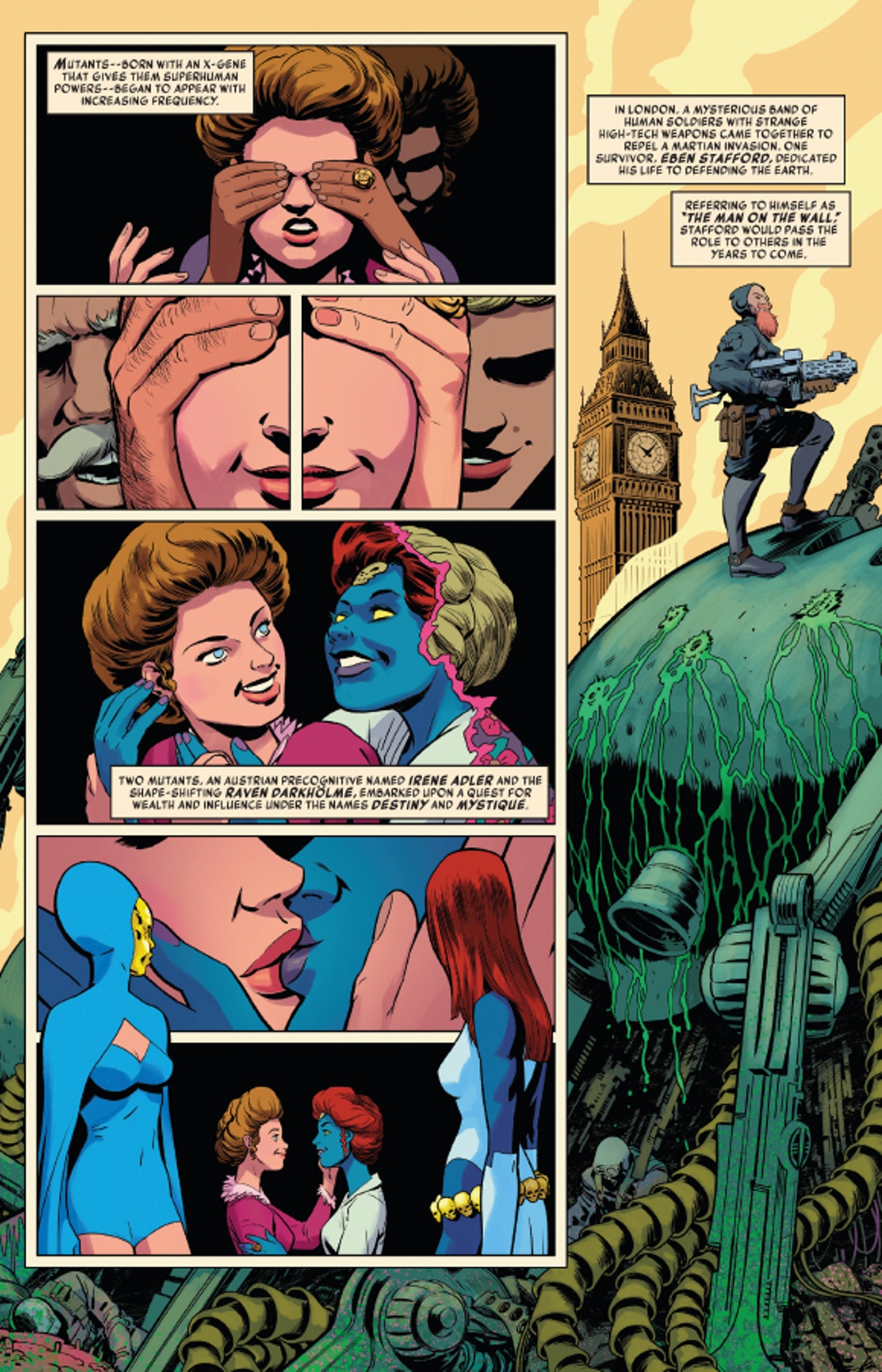
Carol Danvers
When Mystique first appeared in Ms. Marvel, she sought to destroy Carol Danvers. This hatred was undefined at first, but we soon discovered that Destiny had warned Raven that if Carol lived then their adopted daughter Rogue would die. However, the issues in which this explanation occurred actually did not see print until several years after the fact, because the Ms. Marvel series ended a few issues prematurely. Thus, the ultimate context of her hatred of Carol was a blank spot for years. In the final issues of the series, we see Mystique bludgeon Carol’s sometimes-boyfriend to death on-panel. While Mystique is still absolutely the villain of the story either way, at least in this version, Mystique’s motivations were defined clearly.
A major part of the coding around Mystique and Destiny is the fact that they shared a small house with an adopted child named Rogue who, in her pre-X incarnation, eschewed gender stereotypes. These Ms. Marvel issues not appearing for several years was one thing that might have made it easy for readers of the time to completely miss the subtext between Mystique and Destiny.
The Brotherhood and Freedom Force
During the era in which Destiny made her first official appearance, there was an editorial mandate at Marvel against queer characters. Publishing laws that mostly regulated queer-focus literature to be adult-only content in the USA provided a backbone for this choice. Comics had very nearly ended as a medium overall in the ‘50s due to a book (and several articles by various authors) that claimed comics essentially made kids gay, or at least encouraged homosexuality. We see the after-effects of this even today, as publishers and creators regularly tease, then back away from queer inclusion. Though the industry is doing better, in large part due to an influx of queer fandom and creators over many years, there is still a lot of hesitation around characters that have been portrayed as queer through subtext.
So it is that, while writer Chris Claremont showed Mystique and Destiny as being inseparable and aligned in ways that went far beyond those of either a friend or work relationship, there was never a confirmation of their romantic relationship on-page. Often referring to each other as “old friend” even as Mystique showed through thought bubbles that she really never stopped thinking about Irene, this era of their relationship has inspired one metric ton of fanfiction, but there isn’t much that occurs between them on the page besides Mystique’s constant deference to and prioritization of Destiny.
Rogue does eventually leave their home after Mystique urges her to attack Carol Danvers and Rogue absorbs much of her persona and her powerset, leaving Carol in a coma. This damages Rogue in a way she will likely continue to be recovering from for the rest of her life. She joined the X-Men in hopes that Xavier could help her learn to control her power, which caused an unbreachable chasm between her and Mystique. In her own strange way, Mystique continued to try to protect Rogue from afar, though her attempts would become increasingly erratic over time.
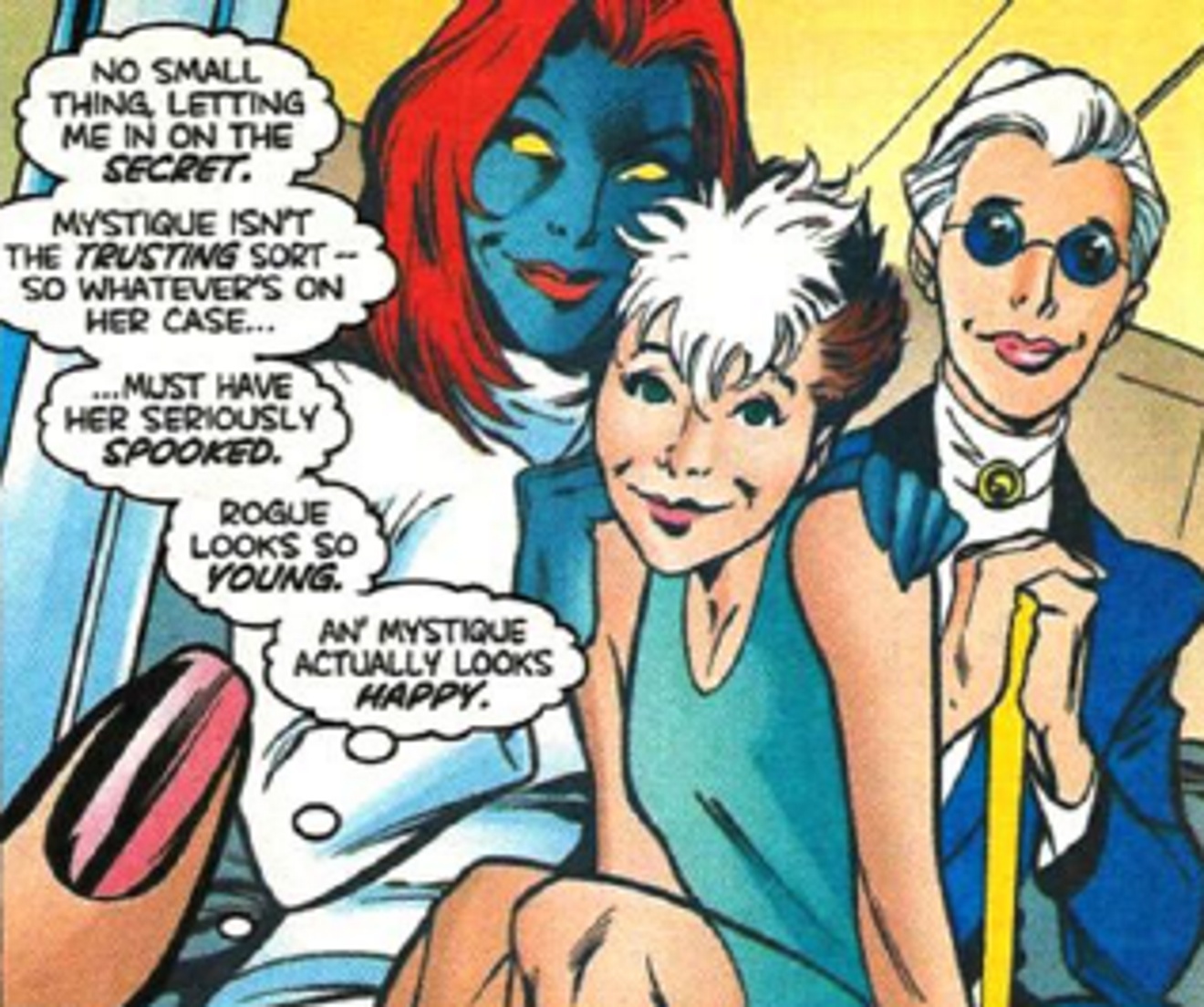
Destiny and Mystique are also mutant rights activists, and this appears to be much of the source of their strongest connection with one another. Both of them orient their entire lives around protecting mutants, though they often resort to extremist measures to do so. There is a lot of untold story around their interests and beliefs, but generally their actions are those of freedom fighters that have lost touch with their compassion towards their fellow living beings in favor of doing what they feel needs to be done for survival.
The two reformed Magneto’s long-defunct team of supervillains, the Brotherhood of Evil Mutants. They attempted to assassinate Senator Robert Kelly, who was strongly critical of mutantkind. For Mystique and Destiny, that meant he was calling into question their right to exist. This action turns out to be the pivotal event that causes the Days of Future Past alternate future, and the X-Men might never see the end of the problems that one action caused. Eventually, the assassination is prevented, and Mystique and Destiny go on to join forces with the government as Freedom Force, leading other convicts into missions as part of a plea bargain with the government. Though the government is anti-mutant at this time, they used their status as “mutant-hunters” as a way of protecting mutants. This put them head-to-head with the similarly motivated early X-Factor.
Marvel Fanfare #40, Uncanny X-Men #255 & #266, and X-Factor Annual #6
In Marvel Fanfare #40, a back-up story from Chris Claremont tells of a meeting between Storm and Mystique, in which Raven expresses her concern for her adopted daughter but also in a roundabout way tells Storm that she trusts her to keep Rogue safe. She then meets up with Irene, and the two share a romantic moment when Mystique takes on the (male) form of Eric Raven so that they can share a dance in public without harassment. Though only a back-up tale, this shows Raven referring to Irene as “my love” and Destiny shedding tears over her memories of her life with Raven.
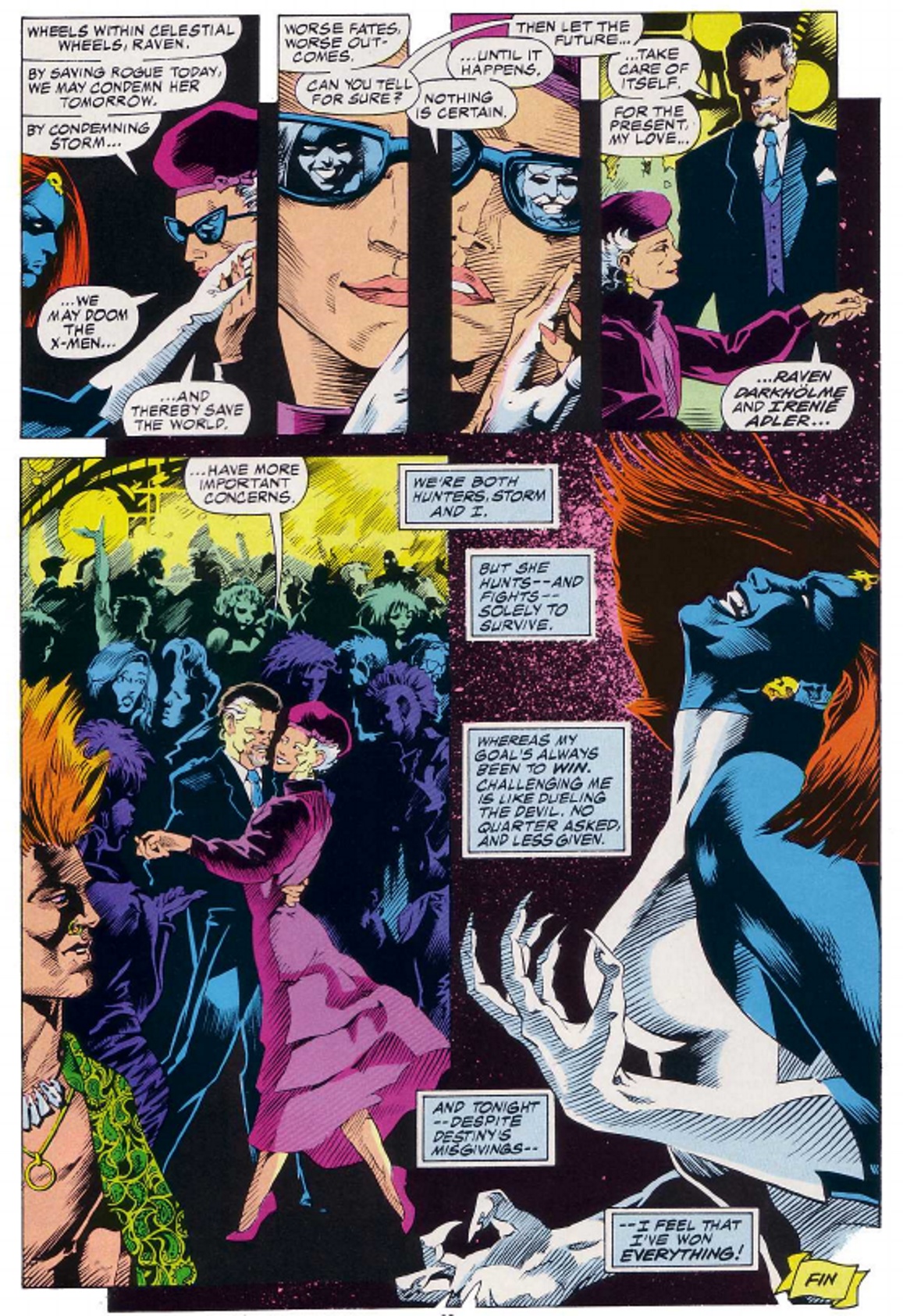
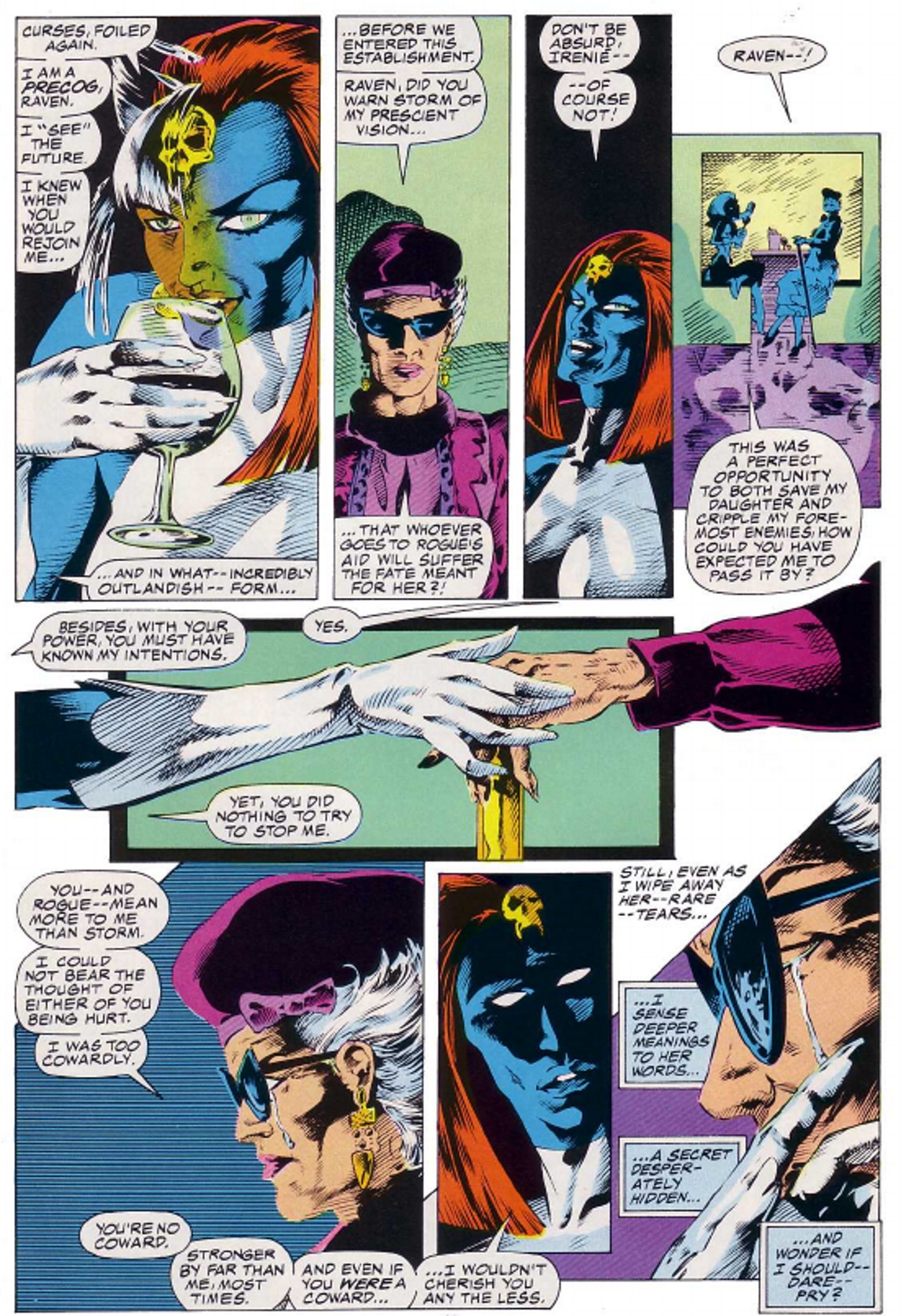
Irene’s death in Uncanny X-Men #255 has been covered by a lot of writers in conversation around the “dead lesbian syndrome” trope, but it’s interesting too because it put an end to a lot of Raven’s character development of the time as well. Irene dies when Legion finds her alone, and Mystique is beyond devastated. Irene had urged Forge to go save Mystique, and in the meantime, Legion had taken her life. Irene knew what was going to happen, and chose to save Raven. When Forge apologizes, Mystique holds Destiny’s body and utters the heartbreaking line, “Sorry… is such an… inadequate word.”
When we would see Raven going forward, she is generally out of control in some way as she reels emotionally from the loss of Destiny and continually fails to find new footing. Signs of mourning are all over Raven’s following appearances. In Uncanny X-Men #266, when an assassin attempts to kill Mystique in her home, Mystique is dismissive of the threat and can only think of Irene, who warned her that this would occur.
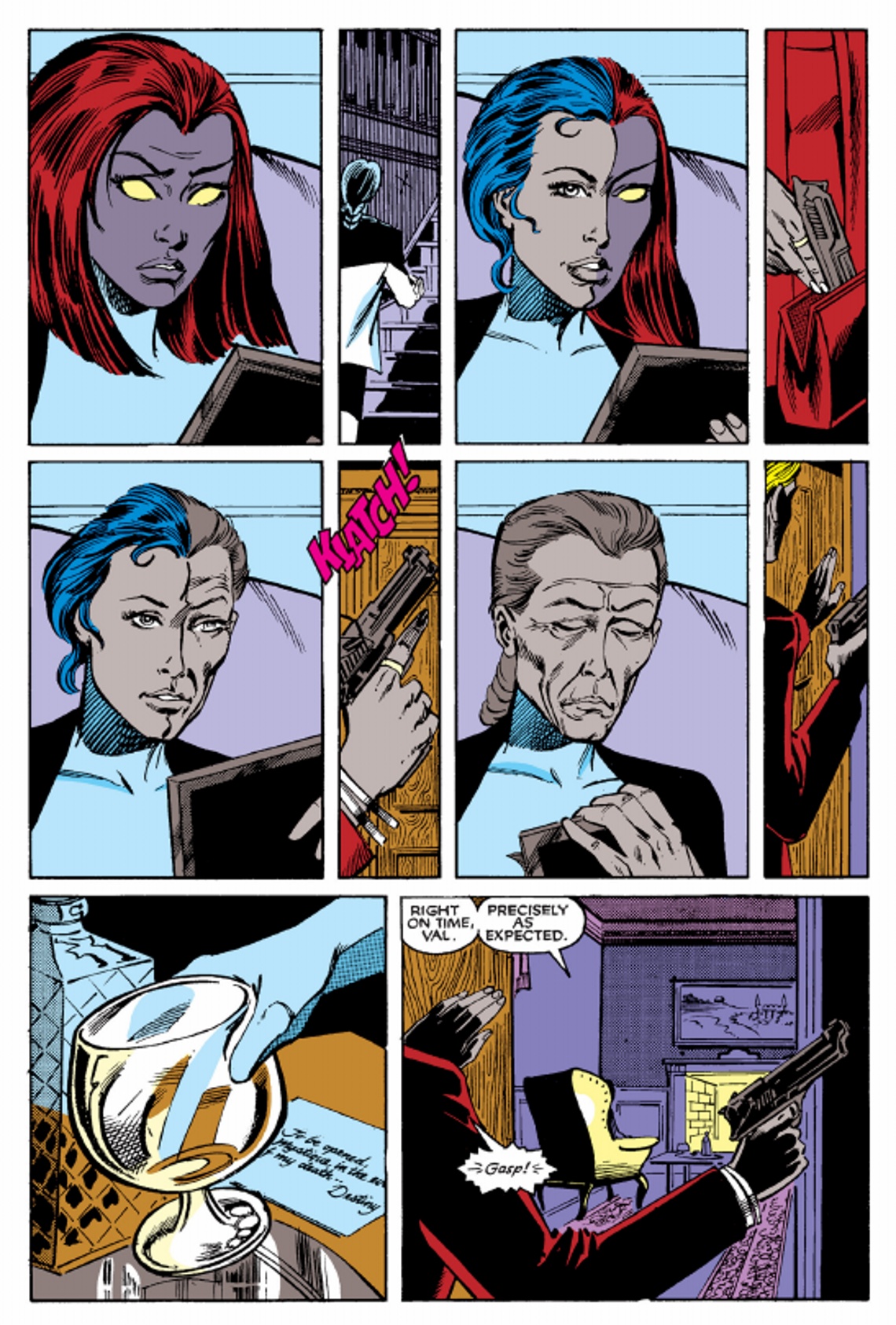
In X-Factor Annual #6, Mystique is on a ship with the objective of spreading Irene’s ashes to the sea. She reflects on the small arguments and separations they had, and the way they’d always found each other again. When she tries to toss the ashes, the wind unpredictably shifts and they blow right back in her face. Mystique laughs and cries both at once. After that, her actions are generally centered around either reconnecting with Rogue or returning Irene to life.
Mystique appeared again in the lead up to Age of Apocalypse. Still angry and seeking revenge even after spending some time with Forge and X-Factor, she attempts to assassinate a comatose Legion. This effectively helps to end her relationship with the team and the man, but she expresses no regret. Irene’s death continues to affect her in a way that eclipses much of her other concerns.
The past and the future
In hindsight we have learned that in their first meeting, Raven appeared as Eric, who was a male detective who Irene sought out for help deciphering her own cryptic prophecies. Eric befriended Irene and then — in a story untold — revealed his true identity, at which time Mystique apparently dedicated her entire life to helping Destiny prevent the apocalyptic predictions of her diaries. While we know that they are lovers, we see no context around this or the role it played in their later lives. We do see Destiny show a preference for Raven’s original form later, but as with so many things between these two, the journey has gone unexplored.
In X-Men #93 and #94, Kitty Pryde and Rogue discover one of Destiny’s diaries, which warns of events that are soon to befall the X-Men. These volumes become a McGuffin for various X-stories. The number of volumes is originally guessed at one, then 13, but is currently unknown. Gambit believed that he had destroyed the copies only for them to pop up again later. They were deemed completely useless and discarded, but then later clearly predicted new events, proving that they had not been examined in full. The diaries are one way in which Destiny continues to make her presence known in Raven’s life.
Where Mystique and Destiny are today
After Destiny’s death, Mystique had a brief relationship with Forge, who she once blamed for Destiny’s demise. This ended badly, and she’s engaged mostly in short-term relationships with men that she uses as a means to an end since. She’s attempted to restart her relationship with Rogue on multiple occasions, going to bizarre, self-destructive lengths. Now the two maintain a distant understanding with one another, though it’s difficult to say where things might go from here.
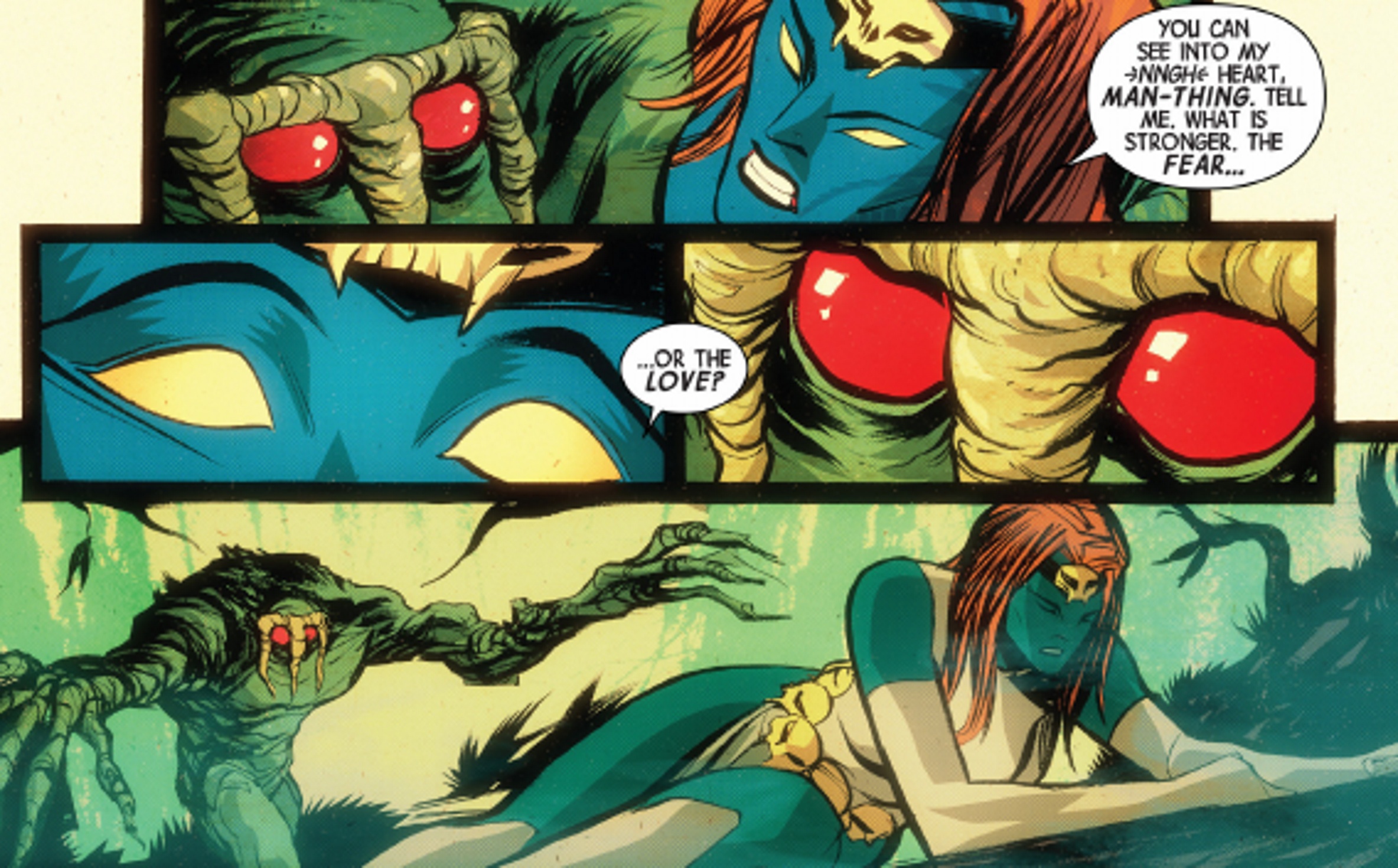
Yet, as recently as the Wolverines series, and into HoX/PoX, the most prominent feature of Mystique’s story shows her as a woman who is more than willing to put everything on the line, including the lives of millions of other people, to bring Destiny back to her if only for a moment. Mystique makes it repeatedly clear that she is only willing to help the X-Men under the promise that they will return Destiny to her. Xavier makes this promise with no intention of following through, which means that at present we’re all waiting for Mystique to find out, go off, and bring Destiny back under her own power. How, when, or if this happens is yet to be seen.
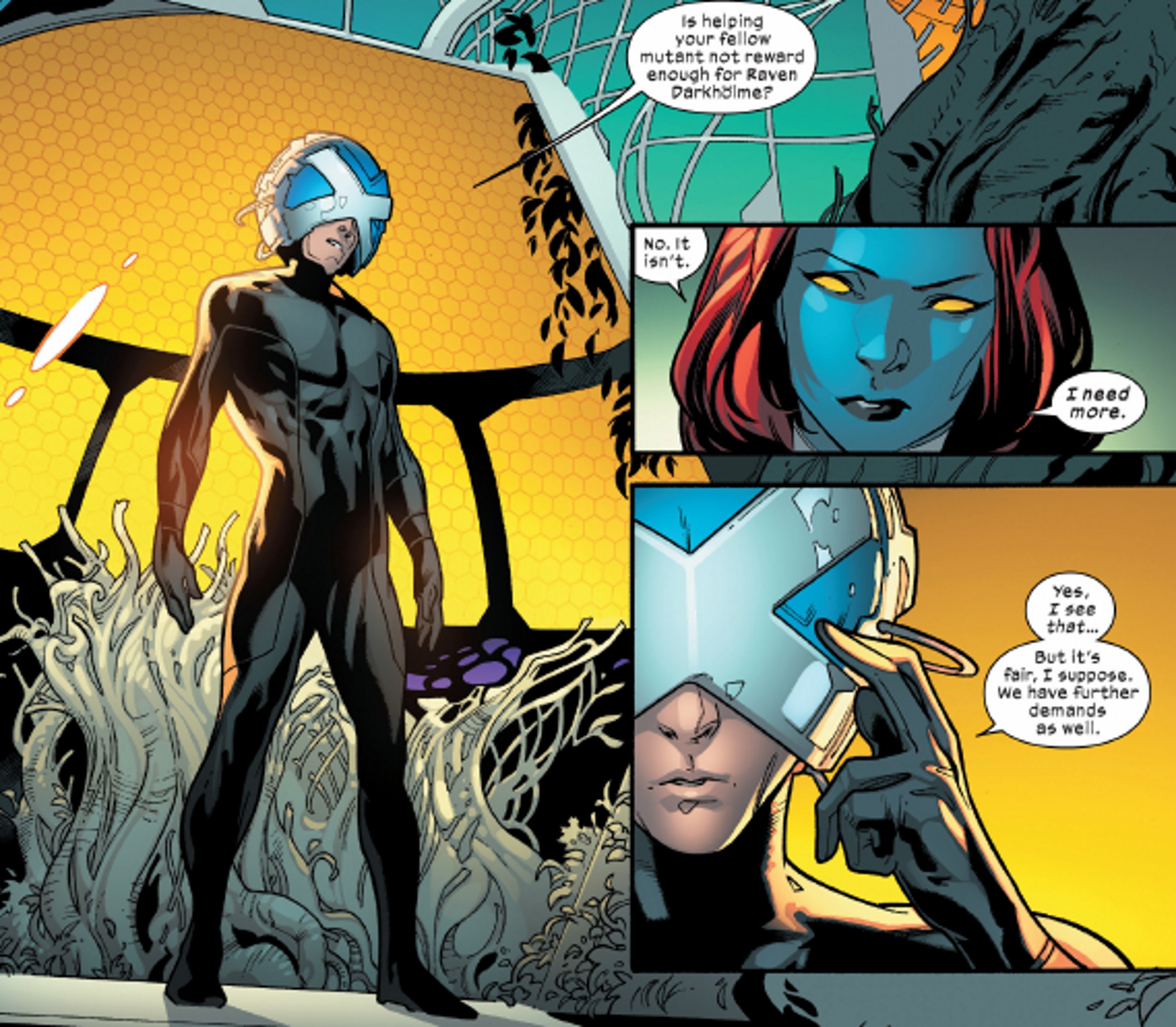
A lot of us are also waiting for a greater attempt from writers to understand them. Mystique’s longterm mourning of her partner has been disregarded and brushed over to the point of chalking it up to being nothing more than the side effect of a vaguely defined mental illness caused by her shapeshifting powers. Yet this is a character we watched try to protect her family at all costs only to lose them. The people around her fail to understand the true devastating pain of a life without Destiny and dismiss their relationship as nothing more than a close friendship. For queer people who have experienced the loss of a partner in a world that fails to acknowledge their relationships, Mystique’s story will read as nothing short of a tragedy.
Specifically poignant for queer readers, the stress Mystique and Destiny feel from the daily attacks on their rights and their lives as mutants and lovers drove them to extreme measures. Though there is little explanation or depth granted this, queer fans have found a lot of allegory there. As we watch our rights be thrown on the chopping block again and again, the psychological effects of such attacks take their toll. Irene and Mystique attempt to self-isolate to protect themselves, using only one another for sources of comfort and refusing to explain their motivations to the world at large. When even that is gone, Mystique is completely at a loss to cope.
The longstanding subtext between these two and the general refusal to make it text or give them any kind of a fulfilling story arc is pretty depressing, and the overt villainization of them by many writers doesn’t do any favors for queer activists in the real world.
These are two characters that had to wait almost four decades to have their first on-page kiss, and it happened as a lead-in to a comics history piece that overall had little to do with them. Yet, Mystique and Destiny have been written as lovers from the beginning. From their first appearances, the love and loyalty they felt for each other was so palpable that it has to date inspired fanfiction and critical commentary that takes their status as one of comics’ most epic love stories as text. Wherever their story might go, Mystique and Destiny have always had the kind of love that transcends the thoughts, desires, and expectations of the outside world.


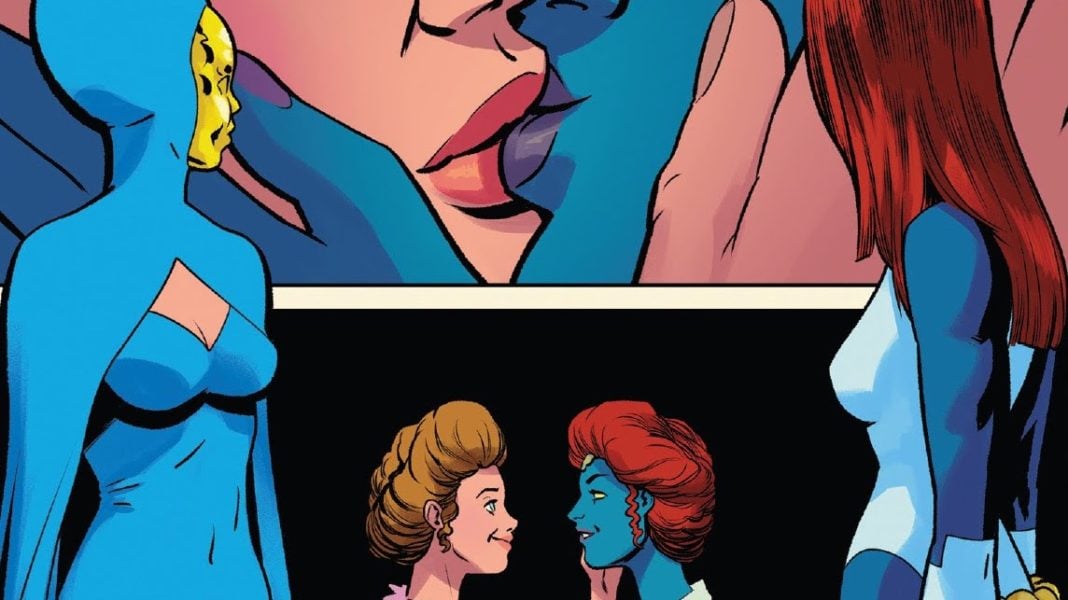
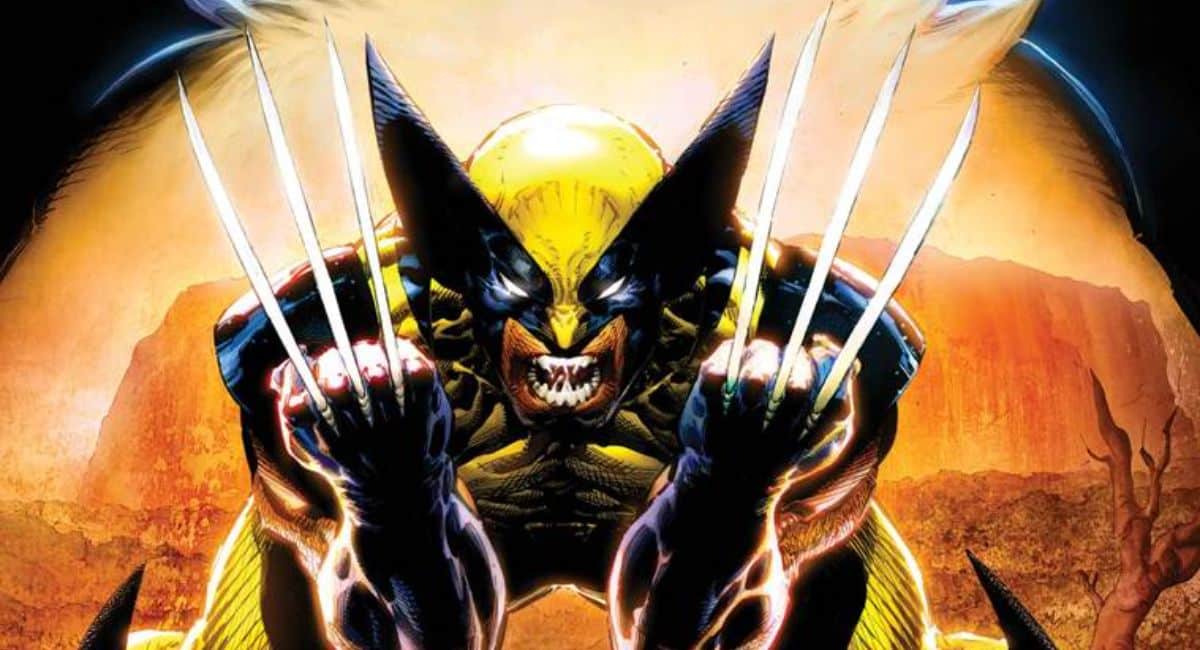
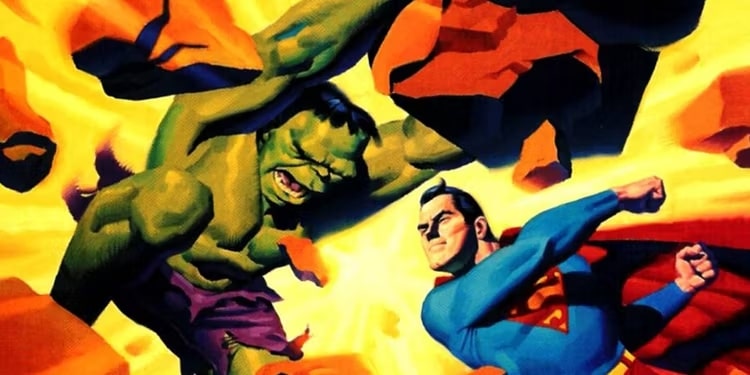




/standing ovation/
That was an amazing piece of writing.
In this Marvel Fanfare page, she is called Irenie, not Irene. Isn’t Irene Adler Sherlock Holmes’ paramour?
I was unaware of this relationship; thank you for spotlighting it for us. Now I can’t wait for Destiny to come back.
Fab article.
Burn it to the ground, Raven!
Comments are closed.